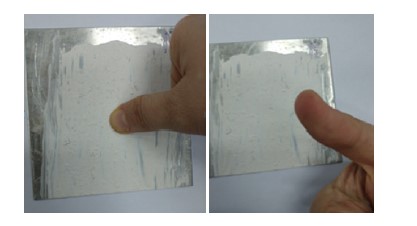Abstract
In many sectors of paint, especially for the use of coating and decorative purposes are available. The development of technology has also affected the paint market.Environmentally friendly, odorless, dust-resistant and water-resistant paints have been produced with increasing demand.
Bamboo is a durable, environmentally friendly and composite biomaterial used to prevent intense and bad odor of the paint. Bamboo has kept the liquid by means of the fibers in the structure for a long time.
In this study, positive results were obtained by carrying out experimental studies on the inclusion of violet fragrance in acrylic organic coating due to the characteristics of bamboo.
1. Introduction
Bamboo is a biological composite, renewable, efficient and environmentally friendly organic material. Bamboo is hygroscopic, absorbs and desorbs moisture to compensate for its moisture content [1-4]. Bamboo is an abundant and sustainable resource in tropics and subtropics.
Due to faster growth, shorter rotation compared to other species and higher mechanical strength, bamboo has received much attention in the last thirty years. Bamboo is the fastest growing and versatile plant in the world. There are more than 1500 documented uses for bamboo.
Housing, handicrafts, paper, panels, coatings etc. use sectors have been discovered by modern science and technology [5, 6]. Since bamboo is a natural source of antioxidants and contains elements such as C, E vitamins, copper, iron, zinc, it is suitable for use in the pharmaceutical and cosmetic sector [7].
Smells are used in every aspect of our daily lives (perfumes, deodorants, after shaving products, cream shampoos and hair creams etc.). Perfumes are pleasant or sweet-smelling compounds produced by organic and chemists [8].
In this study, in order to eliminate the intense odor of the paint, a bamboo and violet fragrance was added to the acrylic organic coatings in order to be long lasting and it was obtained positive results.
2. Experimental Method
The dried bamboos were added to samples of optimally prepared water-based acrylic organic coatings (Figure 2.1). Eight different samples were prepared by adding 0-8% (w/w) violet extract to the paints. These samples were stirred by mechanical homogenization with appropriate mechanical stirrer.

Figure 2.1 Dried bamboo
The prepared samples were diluted with the appropriate amount of water and applied to eight different plates (Figure 2.2) and gas concrete (Figure 2.3). Plates and gas concrete were kept drying for a while and drying, hydrophobicity and odor analysis were performed.

Figure 2.2 Plates after drying
Figure 2.3 Acrylic organic coated gas concrete
3. Results and Discussion
3.1 Drying Test
The test applied to the plates showed that no paint stain remained on the finger. This situation indicated complete drying (Figure 3.1).

Figure 3.1 Drying Test
3.2 Hydrophobicity Test
Water was dropped on the plates, water was flowed without sticking and the surface was hydrophobic (Figure 3.2).

Figure 3.2 The steps of hydrophobicity testing
3.3 Odor Test on Gas Concrete
Violet extracts were added to eight different samples. These samples were applied on gas concrete. The gas concretes were kept for a week to absorb the fragrance with bamboo. At the end of one-week, sensory test was performed, and the result was obtained by absorbing the fragrance of the bamboo.
In order to determine how long the fragrance will remain, the gas concrete applied to the paint was kept in the laboratory for 12 months and it was observed that the effect of the fragrance was still permanent (Figure 3.3).

4. Conclusion
As a result, by means of the bamboo fibers added to acrylic organic coating, the violet fragrance was absorbed to paint. At the end of 12th month, the permanent effect of fragrance in paint was determined.
Thus, it has been observed that long lasting fragrance can be obtained in acrylic organic coatings by means of bamboo for industrial applications.
 Doç. Dr. Nil Acaralı
Yıldız Technical University
Chemical Engineering Department
Doç. Dr. Nil Acaralı
Yıldız Technical University
Chemical Engineering Department
 Kimya Müh. Sibel Demir
Yıldız Technical University
Chemical Engineering Department
Kimya Müh. Sibel Demir
Yıldız Technical University
Chemical Engineering Department
References
[1] Jakovljević S. and Lisjak D. (2019), Investigation into the Effects of Humidity on the Mechanical and Physical Properties of Bamboo, Construction and Building Materials, 194:386-396.
[2] Huang J. and Young W., (2019), The Mechanical, Hygral, and Interfacial Strength of Continuous Bamboo Fiber Reinforced Epoxy Composites, Composites Part B: Engineering, 166:272-283.
[3] Liu Z. et al., (2018), Ash Fusion Characteristics of Bamboo, Wood and Coal, Energy, 161:517-522
[4] Mali P. and Datta D., (2018), Experimental Evaluation of Bamboo Reinforced Concrete Slab Panels, Construction and Building Material,188:1092-1100.
[5] Fang C. et al., (2018), An Overview on Bamboo Culm Flattening, Construction and Building Materials, 171:65-74.
[6] Peng P. and She D., (2014), Isolation, Structural Characterization, and Potential Applications of Hemicelluloses from Bamboo, Carbohydrate Polymers, 112:701–720.
[7] Nirmala C. et al., (2018), Bamboo: A Rich Source of Natural Antioxidants and its Applications in the Food and Pharmaceutical Industry, Trends in Food Science & Technology, 77:91-99.
[8] Abedi G. et al., (2018), The Survey of Analytical Methods for Sample Preparation and Analysis of Fragrances in Cosmetics and Personal Care Products, TrAC Trends in Analytical Chemistry, 102:41-59.







 Doç. Dr. Nil Acaralı
Yıldız Technical University
Chemical Engineering Department
Doç. Dr. Nil Acaralı
Yıldız Technical University
Chemical Engineering Department
 Kimya Müh. Sibel Demir
Yıldız Technical University
Chemical Engineering Department
Kimya Müh. Sibel Demir
Yıldız Technical University
Chemical Engineering Department